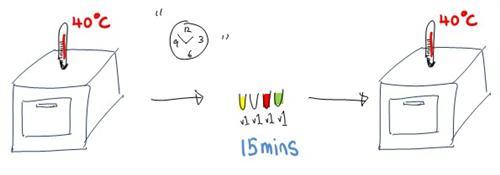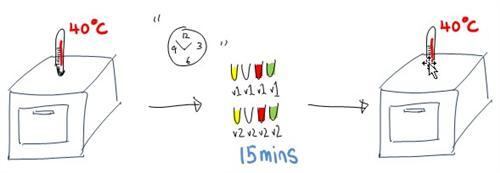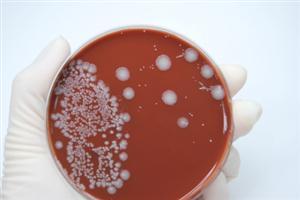| Complexity level: | 9 |
| Project cost ($): | 50 |
| Time required: | 2 hours to prepare (Day 0), 7 days incubation period (Day 1 to Day 7), 15 minutes each day (from Day 1 to Day 7), 30 minutes to transfer samples on Petri Dish (Day 8) 24 hours for inoculation, Observation on Day 9 |
| Material availability: | The school biology laboratory should provide all the necessary materials. |
| Safety concerns: | Goggles and gloves must be worn at all times to prevent contamination as we’re dealing with biohazardous materials. Adult supervision encouraged. |
Hypothesis
Extremely high temperatures will kill more bacteria extremely low temperatures.
Overview
Nature of Bacteria
Bacteria are single-celled living organelles. This means they are self-sustaining life forms, able to metabolize and reproduce. To facilitate the biological functions of the bacteria, they contain carboxysomes. Carboxysomes are protein based structures containing enzymes.
As such, knowing the nature of bacteria leads us to understand the effect heat has on bacteria. Being mainly protein-based, bacteria undergo denaturation when it is exposed to extreme heat, acid and hydrolysis. This means the proteins lose their cellular shapes, lose cell activity and this eventually leads to cell death.
An alternative for killing bacteria
Vinegar, widely known for its powerful antibacterial property, is a traditional cleaning agent and it works just as well or even better than common disinfectants.
How do I use vinegar for cleaning purposes?
An easy way to keep the multi-functional vinegar at hand is to have a bottle of pure 5% vinegar near your cutting board or in your bathroom and spray it onto any surface you wish to clean and disinfect. Vinegar gives out a strong smell once exposed to air. However, it disappears within hours.
Scientific Terms
Materials
You’ll need the following materials to carry out this experiment:
- 7500 micro liters Bacillus Cereus
- 7500 micro liters Clostridium Perfringens
- 7500 micro liters Mycobacterium Tuberculosis
- 7500 micro liters Salmonella
- Cotton buds
- Normal saline solution
- 120 Vials / Test Tubes with stoppers
- 120 Petri dish filled with blood agar
- A box of disposable plastic pipette tips
- A 10 micro liter pipette
- A 250 micro liter pipette
- Calorimeter
- Goggles
- Lab coat
Procedure
1. The independent variable of this experiment is the temperature of storage of the bacteria. The dependent variable of this experiment is the number of bacteria colonies killed. The few constants in this experiment include: the amount of bacteria used, the type of blood agar used and the length of time used.
2. Make 70% turbidity suspension in the normal saline solution for each different bacterium.
3. Separate one solution of bacteria between 30 vials, with 250 micro liters per vial.
4. Choose 5 of these vials and label them according to their names, their temperature of storage, and their vial number. For example, the 5 vials for Salmonella would read
a. At 40 degrees Celsius:- SAL V.1 (40°), SAL V.2 (40°), SAL V.3 (40°), SAL V.4 (40°), SAL V.5 (40°)
b. At 35 degrees Celsius:- SAL V.1 (35°), SAL V.2 (35°), SAL V.3 (35°), SAL V.4 (35°), SAL V.5 (35°)
c. At 5 degrees Celsius:- SAL V.1 (5°), SAL V.2 (5°), SAL V.3 (5°), SAL V.4 (5°), SAL V.5 (5°)
d. At -20 degrees Celsius:- SAL V.1 (-20°), SAL V.2 (-20°), SAL V.3 (-20°), SAL V.4 (-20°), SAL V.5 (-20°)
e. At -30 degrees Celsius:- SAL V.1 (-30°), SAL V.2 (-30°), SAL V.3 (-30°), SAL V.4 (-30°), SAL V.5 (-30°)
f. At -60 degrees Celsius: - SAL V.1 (-60°), SAL V.2 (-60°), SAL V.3 (-60°), SAL V.4 (-60°), SAL V.5 (-60°)
5. Repeat steps 3-4 with the other bacteria and all different temperatures.
6. Store the respective vials at the respective temperatures. Note the time.

7. At the same time on day one (24 hours after you have put the vials in the respective temperatures), remove all vials labeled “V.1” and let them sit for 15 minutes at room temperatures.
8. Reheat or refreeze these vials respectively.

9. At the same time on day two, remove all V.1 and V.2 vials and let them sit for 15 minutes at room temperature.
10. Reheat or refreeze these vials respectively.

11. Repeat steps 6-7 for 3 more days and eventually taking out V.3 on the third day, V.4 on the fourth day and so on and so forth for 7 days.
12. On day 8, remove 10 micro liters from each vial using a pipette. Transfer each specimen to a clearly labeled blood agar Petri Dish. The naming should follow that of step 4 as above.
13. Spread the bacteria using a cotton bud (sterile) onto the surface of the blood agar.
14. Put the Petri dishes into an incubator for 24 hours at a pre-set temperature of 37 degrees Celsius.
15. After that, count the number of colonies in each dish under fluorescent light and record the number in the table below.



Results
The following table is meant for recording the results of this experiment.
Bacillus Cereus:
| Number of hours bacteria were stored | Storage temperatures (degree Celsius) | ||||
| 40 | 35 | 5 | -20 | -30 | -60 |
| 24 | |||||
| 48 | |||||
| 72 | |||||
| 96 | |||||
| 120 | |||||
| 144 | |||||
| 168 | |||||
| Average |
*Draw 4 more similar tables for the other 3 bacteria.
Conclusion
Extreme high temperatures will kill more bacteria. As the temperature lowered, more bacteria colonies survived.
This information is vital for scientists to develop effective methods for killing harmful bacteria. Knowing the tolerance levels of bacteria can help scientists and doctors establish a minimum temperature for sterilizing medical equipment to prevent contamination.
Also consider
Study the nature of the bacteria in this experiment. How do they differ?
What causes the discrepancies between their heat tolerance levels?
What are the other alternatives to kill bacteria?
References
http://www.microbiologybytes.com/iandi/3a.html
http://en.wikipedia.org/wiki/Bacteria

